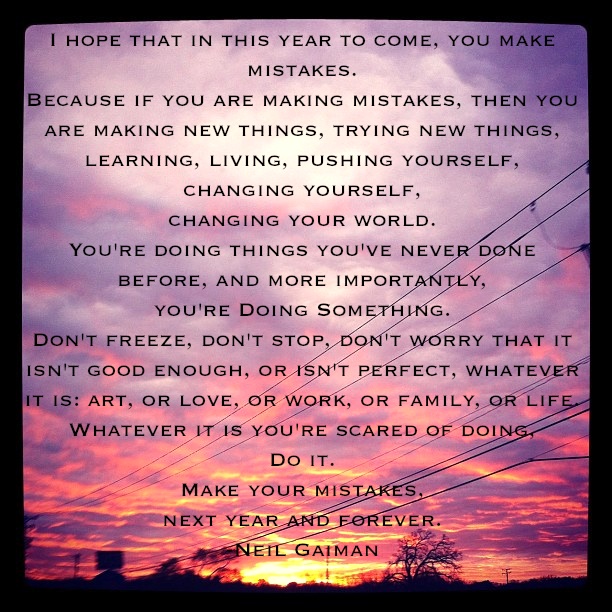
…And here I thought I was actually going to get to bed! A friend of mine just posted this quote on Facebook. I just had to share it here. I added my own image, taken last fall, to dress it up a bit. 🙂 This one hit home. Goodnight, Blogland!


…And here I thought I was actually going to get to bed! A friend of mine just posted this quote on Facebook. I just had to share it here. I added my own image, taken last fall, to dress it up a bit. 🙂 This one hit home. Goodnight, Blogland!
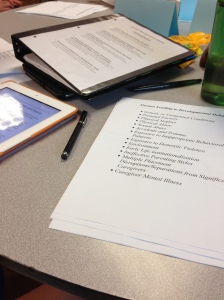 *Again, this is my title for the licensing classes, clearly not theirs. To be more accurate, Session 3 was entitled, “Meeting Developmental Needs: Attachment.” It included a laundry list of the various types of trauma that a child can experience before being placed in foster care. Physical abuse, sexual abuse, neglect, medical neglect, emotional/psychological maltreatment, etc. Once defined, we went on to discuss how the traumatic stress from these experiences may manifest in a child’s behavior. It reminded me of reading the list of side effects included with a bottle of aspirin It was anything and everything that might go wrong and by the time you are done reading it you are convinced that you would rather suffer your headache instead of dying a slow and painful death that one dose of aspirin is surely to inflict upon you. It’s important to know but what are the chances of it all going wrong? Pretty slim. It was important to keep that in mind as we delved deeper into the subject.
*Again, this is my title for the licensing classes, clearly not theirs. To be more accurate, Session 3 was entitled, “Meeting Developmental Needs: Attachment.” It included a laundry list of the various types of trauma that a child can experience before being placed in foster care. Physical abuse, sexual abuse, neglect, medical neglect, emotional/psychological maltreatment, etc. Once defined, we went on to discuss how the traumatic stress from these experiences may manifest in a child’s behavior. It reminded me of reading the list of side effects included with a bottle of aspirin It was anything and everything that might go wrong and by the time you are done reading it you are convinced that you would rather suffer your headache instead of dying a slow and painful death that one dose of aspirin is surely to inflict upon you. It’s important to know but what are the chances of it all going wrong? Pretty slim. It was important to keep that in mind as we delved deeper into the subject.
We learned that acute trauma is just one traumatic event, chronic trauma is when a child has experienced multiple traumatic events, and complex trauma is a term used to describe both exposure to chronic trauma and the long-term impacts. Reading about trauma reminders was akin to learning about PTSD in soldiers that react to environmental triggers that send them back into the emotional state of war even though they are safe at home. I highlighted the quote, “Always remember to react to the context of a child’s behavior, not to the behavior itself.” in my handbook. I may need to tattoo that on my forehead so I can remember it as a mantra. (Maybe on Mr. Something’s forehead so I can read it at all times?)
Returning to the big idea of Session 3, we were told over and over that the key to developing attachments with children suffering from trauma is patience, consistency, and seeking out moments when positive attention and experiences can be shared. We learned of the jigsaw puzzle that is each child in foster care. 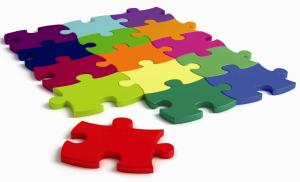 It served as a reminder that even though a child may chronologically be 8 years old they could be academically a 6 year old, emotionally a 4 year old, but have the life experiences of a 16 year old. I’m no stranger to the jigsaw puzzle, walking into my classroom of second graders I am always aware that “second grader” is a loose label for most of them. Academically speaking alone, I can have a span of non-readers through students reading at a fifth grade level all sitting in my classroom. Constructing each student’s puzzle has become second nature to me and the prospect of discovering and nurturing my own children’s jigsaw puzzle intrigues me.
It served as a reminder that even though a child may chronologically be 8 years old they could be academically a 6 year old, emotionally a 4 year old, but have the life experiences of a 16 year old. I’m no stranger to the jigsaw puzzle, walking into my classroom of second graders I am always aware that “second grader” is a loose label for most of them. Academically speaking alone, I can have a span of non-readers through students reading at a fifth grade level all sitting in my classroom. Constructing each student’s puzzle has become second nature to me and the prospect of discovering and nurturing my own children’s jigsaw puzzle intrigues me.
I’d like to amend my title. I wouldn’t say that Session 3 scared the crap out of me, but it was heavy. There really wasn’t any information that I wasn’t expecting, it was just difficult to get it all at once. Now that I am a week removed from it, I can file it away in my schema and access the pieces of it that I will need in the future. I won’t, under any circumstances, ever need it all at once ever again. One of our sassy, no-nonsense instructors reminded us plainly, “If you don’t think you can handle a child that has been sexually abused, tell your case worker, flat out. Don’t give the politically correct answer or the answer that you think will make you look the best. Be honest with what you can and cannot handle.” I need this one tattooed somewhere too. I tend to be a people pleaser but this is one case that I need to be honest with everyone, including myself about what we can and cannot handle.
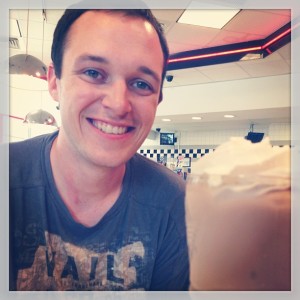 Thursday was our 4th wedding anniversary. Pressed for time, as usual, before class we grabbed a quick dinner at Steak N’ Shake. Now, even though it’s been four years of marriage for us, it has actually been twelve and a half years together. (See our story here. Awww…) When we first met as broke teenagers, Steak N’ Shake was one of our places. There is one across from our movie theater. Dinner and a movie was a big night out even if it was shakes and cheese fries! So, despite the underwhelming culinary experience, we were still able to sneak in a place that held some memories for us.
Thursday was our 4th wedding anniversary. Pressed for time, as usual, before class we grabbed a quick dinner at Steak N’ Shake. Now, even though it’s been four years of marriage for us, it has actually been twelve and a half years together. (See our story here. Awww…) When we first met as broke teenagers, Steak N’ Shake was one of our places. There is one across from our movie theater. Dinner and a movie was a big night out even if it was shakes and cheese fries! So, despite the underwhelming culinary experience, we were still able to sneak in a place that held some memories for us.
<—I love this guy! 🙂 …and a good milkshake! 😉
The evening culminated in Session 4- “Meeting Developmental Needs: Loss.” Isn’t it romantic? Luckily class ended way earlier than normal, mainly because spending a session reflecting on loss and the grieving process often conjures up difficult memories for those in the class. Our instructor explained that there was no reason to beat the idea into the ground. Every child in foster care has experienced an unexpected loss. Even the loss of an abusive parent can be devastating because, as we learned in Session 3, attachments can be developed even when needs are only sporadically met. The woman sitting next to me, who returned after her one session hiatus leaned over in the midst of discussing the many manifestations of grief and whispered, “This is scaring me!” I told her that I’d be worried about her if she wasn’t scared. She later told me that she has already raised two children of her own and thought that it wasn’t so bad, so how hard could taking on a foster child be? I think she’s changing her tune.
Our homework was to complete a Loss History Chart, it maps the age at which we suffered a loss, the type of loss (an important person, health, sense of safety or well-being), what happend, how the loss effected us, and help that was received. It wasn’t exactly how I envisioned we’d be spending our 4th anniversary, but the bigger idea of moving forward with our “someday” plan seems like reason enough to celebrate.
Session two was actually called “Teamwork toward Permanence” but I like my name better. 🙂 Our second in-class session went well. We had another cheesey sunshine and rainbows video from DCFS where the birth parent actually hugged the social worker and proudly proclaimed, “I LOVE having a social worker in my life. She saved me!” Before the video faded to black, the birth family and foster family were gathered together in a cozy living room, laughing and smiling over the children like they had always been extensions of one another’s family trees.
Touching.
As our instructor switched off the VCR she turned to us and said, “Okay, now let’s talk about real life.” Including air quotes around “real life.”
I have to admit, I love that they are not sugar-coating any of the “one big happy family” propaganda that DCFS is providing. I am not discrediting the idea that there may be wonderful teams of birth families, foster families, social workers, and children that hold hands and come together for an afternoon at the zoo, but after blog reading for 16 months, you, my fellow bloggers, are painting a much different picture. Like my instructors, I thank you for the dose of the “real world.”
The big idea of the day was, “Be prepared to work with birth families, don’t judge them.” The woman next to me shook her head in disapproval, “I thought they just brought you some kids and you got to take care of them…” She wasn’t in class this week. Is she over it?
We learned the about idea of concurrent planning (which I can thank Carrie Ann, from Foster Wee, for sharing about here first) and how the team will be working on reunification for the child with their birth families all the while also planning for termination of rights and adoption. It looks good on paper but my “real world” lessons tell me otherwise.
We did a simple exercise where we were given a few minutes to answer the following questions:
1. What do you plan to do tomorrow?
2. Who do you plan to have with you tomorrow?
3. What do you want to be doing one year from now (personally or professionally)?
4. Who do you plan to have with you?
5. What would you like to accomplish in the next five years?
6. Who would you like to have sharing your accomplishments?
We handed in our worksheets and our instructor promptly ripped them up. There were a few gasps but I saw it coming. I get it. A person, of any age, is going to have plans and when those plans are disrupted, they are not going to be happy. As we have heard more than once now, no kid ever wakes up and says, “I want to be taken by DCFS today.” This feeds into the idea that no one (foster parents or otherwise) should ever expect their foster/adopted child to be grateful. Even if being abused, they are attached to the adult in their life and you are different and strange and you interrupted their plans, no matter how big or small.
Two other key ideas we hit on were connections and continuity. Connections in terms of establishing long-term and ongoing relationships with people who have a lifetime commitment to the child. Connections provide belonging, stability, and a sense of cultural community. Continuity refers to children’s ability to understand and make connections between their past, present and the future. It has to do with knowing where you’ve been and where you’re going. It’s a sense of familial and cultural heritage.
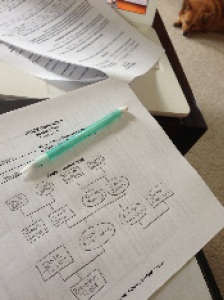 Enter the homework. In addition to about 20 pages of reading we were required to complete a genogram, or a drawing of our family tree structure. It examines family heritage and current family relationships. It’s a chart of our hereditary past and present. (My photo is purposely pixelated to obscure family names and to apparently protect the identity of my dog napping on the floor.) It resulted in a phone conversation with my mom where suddenly I was picking her brain for birth dates and dates of death. I love how the mind works, as she was rifling through her mental schema for the information I needed she would mutter things like, “She passed just after we moved to…” or “Well he was this many years old when your father was born so…” Family factoids tied to family trivia. Without cousins, my genogram came out quite compact. Mr. Something’s genogram, with an extensive supply of aunts, uncles, half aunts, and half uncles, required computer charting and quite a few creative guesses on his mom’s part.
Enter the homework. In addition to about 20 pages of reading we were required to complete a genogram, or a drawing of our family tree structure. It examines family heritage and current family relationships. It’s a chart of our hereditary past and present. (My photo is purposely pixelated to obscure family names and to apparently protect the identity of my dog napping on the floor.) It resulted in a phone conversation with my mom where suddenly I was picking her brain for birth dates and dates of death. I love how the mind works, as she was rifling through her mental schema for the information I needed she would mutter things like, “She passed just after we moved to…” or “Well he was this many years old when your father was born so…” Family factoids tied to family trivia. Without cousins, my genogram came out quite compact. Mr. Something’s genogram, with an extensive supply of aunts, uncles, half aunts, and half uncles, required computer charting and quite a few creative guesses on his mom’s part.
Again, I got it. Bringing a child into our family adds a different type of branch to our tree and also provides them with a tree that isn’t really theirs to begin with. It’s a matter to never forget.
Purely by coincidence, I found myself climbing deeper (higher?) into my family tree just a few hours after that phone conversation with my mom. She and my father were headed out-of-town for a road trip and I finally got the opportunity I had been waiting for. In April, my parents will be celebrating their 50th wedding anniversary. I have known for a while that I wanted to make a DVD slideshow of pictures of them spanning the 50 years of their marriage. A project that would include raiding their family albums and scanning A LOT of photos. (If this post mysteriously disappears it’s because I have finally shared my blog with my mom and I’m being very top secret about the whole anniversary project. She was running internet on a dial-up connection until about a month ago, so spending casual time online reading blogs was not within her realm of patience!) So, with them safely across state lines, I headed to their house and took on the task.
After 3 1/2 hours of scanning photos I had taken a journey, not just through my own childhood, but into the twenty-ish years they spent together before I came along. In my scope, that’s practically a lifetime they spent childless and together. A lifetime that I know very little about. Apparently, they had secret lives as movie stars in the 60s. Could this pic be any more amazing? 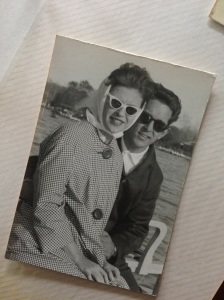 Out of the albums I unearthed, my favorite was one I had never seen before. It was stashed away in the back of a shelf, dusty. It was faded green leather with the word PHOTOS embossed across the front, black photo corners fastened the square snapshots (way to bring it back Instagram) to large black pages. My father’s neat handwriting was there with simple dates and locations penned in white under the images. Oh, I should have taken a picture of it. I’m hoping to return tomorrow, perhaps I will snap one then. Already feeling like I was being super sneaky taking on this project, this album was what I had been hoping to find. It started with pictures around the time of, and including, their own wedding. There were honeymoon pictures from the beaches of Miami and a photo of my mom standing outside their first home, an apartment above my father’s parents’ house, labeled “First morning back.”
Out of the albums I unearthed, my favorite was one I had never seen before. It was stashed away in the back of a shelf, dusty. It was faded green leather with the word PHOTOS embossed across the front, black photo corners fastened the square snapshots (way to bring it back Instagram) to large black pages. My father’s neat handwriting was there with simple dates and locations penned in white under the images. Oh, I should have taken a picture of it. I’m hoping to return tomorrow, perhaps I will snap one then. Already feeling like I was being super sneaky taking on this project, this album was what I had been hoping to find. It started with pictures around the time of, and including, their own wedding. There were honeymoon pictures from the beaches of Miami and a photo of my mom standing outside their first home, an apartment above my father’s parents’ house, labeled “First morning back.”
The pages that followed included family gatherings and lots of other weddings. My dad smiled politely as a groomsman with unknown bridesmaids on his arm. My mom clutched bouquets next to glowing brides. It was “that time” of their lives. Everyone was getting married. We’ve all had summers like that, “What? Another wedding?” I was recognizing the faces of family friends that became my honorary aunts and uncles twenty years later. Sitting there at my parents desk with albums scattered around me, I came to the realization that my family genogram could have been, should have been, much bigger. These dear friends of my parents are as much family to me as my biological aunts and uncles. Does it matter that they aren’t officially on my tree? No! When did I finally realize that they weren’t actually related to us?
I was seeing the reflection of myself in those faces. Bridesmaids in matching dresses, boutonnieres pinned to tuxedo lapels, friends smiling around banquet tables draped in white linens, it’s not far from what the last several years have been for me. I’ve said since the beginning that part of the reason Mr. Something a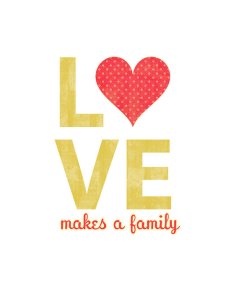 nd I hope to foster to adopt is to bring a child into the nurturing fold of our family and friends. Our friends, that have trees of their own but will no doubt be “aunt” and “uncle” to our children. The genogram was supposed to bring us to the realization of the loss that one would feel to not have that information, that sense of self and history.Yet, I came to the entirely different conclusion that there is far more than that tree in one’s support system. You can feel loved, and nurtured, and protected by anyone that devotes their energy to caring for you. A tree can’t grow alone in the dark. It is our friends that make up all the rest. I cherish my family tree but I’m also so grateful that it grows in a forest.
nd I hope to foster to adopt is to bring a child into the nurturing fold of our family and friends. Our friends, that have trees of their own but will no doubt be “aunt” and “uncle” to our children. The genogram was supposed to bring us to the realization of the loss that one would feel to not have that information, that sense of self and history.Yet, I came to the entirely different conclusion that there is far more than that tree in one’s support system. You can feel loved, and nurtured, and protected by anyone that devotes their energy to caring for you. A tree can’t grow alone in the dark. It is our friends that make up all the rest. I cherish my family tree but I’m also so grateful that it grows in a forest.
(“Love makes a family” image found at Manchester Studio on Etsy.)
So, yesterday afternoon I drove the 25 miles to Mr. Something’s office with a car picnic tucked safely in the backseat. Car picnics are an actual thing in the Something household. 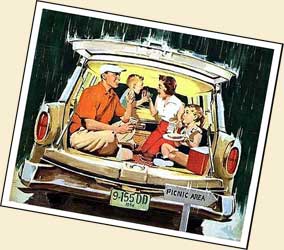 In our early days they manifested out of necessity. The first (correct me, Mr. Something, if my memory fails me) was the time we stopped for pizza but the restaurant was closed. They were still taking orders for take-out so we took-it-out to the car and ate it in the parking lot. Ta da! The birth of the car picnic! Another memorable one was a birthday picnic that I had planned for Mr. Something’s birthday at our favorite park. Unfortunately, having an early May birthday in the midwest doesn’t always guarantee picnic weather. Blustery winds forced us to picnic in the car, parked with a decent view of the pond. Calling it a car picnic makes it seem far less pathetic than what it really is, eating in the car.
In our early days they manifested out of necessity. The first (correct me, Mr. Something, if my memory fails me) was the time we stopped for pizza but the restaurant was closed. They were still taking orders for take-out so we took-it-out to the car and ate it in the parking lot. Ta da! The birth of the car picnic! Another memorable one was a birthday picnic that I had planned for Mr. Something’s birthday at our favorite park. Unfortunately, having an early May birthday in the midwest doesn’t always guarantee picnic weather. Blustery winds forced us to picnic in the car, parked with a decent view of the pond. Calling it a car picnic makes it seem far less pathetic than what it really is, eating in the car.
We wanted to make an early start to the city last night, not knowing exactly where we were going for the first of our licensing classes, the event called for a car picnic. As we unwrapped our sandwiches (Boar’s Head lunch meat, fresh French bread… we don’t mess around) there were mixed feelings between us. We trade off having the “What the f- are we doing?” feeling and Mr. Something was there last night but, despite the feeling, was looking forward to taking another actual step in this journey. I was excited and ready for information. When I shared that sentiment, we came to the realization that we have never been students together. In our 13 years of knowing each other we have spent more than half of those years as students; high school, college, grad school, traffic school… 😉 Educational careers paralleling each other, but never have we sat in a classroom together. Suddenly the ridiculous contrast between Mr. Something as a student and myself as a student became humorous.
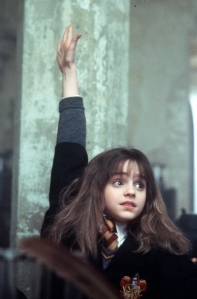 Since completing college, I love being a student. As a teacher I am afforded professional development opportunities every year and, as crazy busy as it was, I thrived in grad school. I was the one that showed up to class with the new pack of pens and a pristine notebook, ready to write every important word down. I actually enjoy the activities that others might be “too cool” for. I’m a teacher, what I teach and how I teach has layers of purpose. I optimistically like to assume that the instructors of my classes have a similar agenda. Like there’s something bigger going on and I better play along or I might not get it. It’s okay, I’ll proudly fly my nerdy student flag.
Since completing college, I love being a student. As a teacher I am afforded professional development opportunities every year and, as crazy busy as it was, I thrived in grad school. I was the one that showed up to class with the new pack of pens and a pristine notebook, ready to write every important word down. I actually enjoy the activities that others might be “too cool” for. I’m a teacher, what I teach and how I teach has layers of purpose. I optimistically like to assume that the instructors of my classes have a similar agenda. Like there’s something bigger going on and I better play along or I might not get it. It’s okay, I’ll proudly fly my nerdy student flag.
I’m realizing now that this portrait of myself as a student might lead one to believe that Mr. Something is less than a good student but that couldn’t be more wrong. He did great in school and has lasting memories and connections with teachers that I’ve never known the likes of. We are simply different types of learners and embarking once again into studenthood side-by-side was a first for us that I’d never considered. I was suddenly looking forward to the experience for all new reasons.
Another 30 miles… this time into the city… during rush hour… sitting… on the expressway…
There was more traffic than we thought but we had planned for extra time and arrived early, after going to the wrong building first, to the meeting room where our classes would be held. A mix of people began to file in and fill up the places at the tables. There were perhaps 20 of us and two instructors. The instructors are two straight-forward, no-nonsense women that share over three decades of foster parenting and case working between them. They keep it real, no sugar coating, and both have a fabulous sense of humor which I know will help with our twice weekly, late night sessions.
Once papers were passed out, internet connections established, and class expectations defined, we began to introduce ourselves. For some reason, when thinking about these classes, I never once considered the other people that would be taking them with me. All at once I looked around and realized that I was, for the first time, sitting among 20ish like-minded future foster parents. We shared our reasons for wanting to foster/adopt but no one had to justify their choice. One woman sought to foster pregnant teenage girls to help teach them how to care for their children, another only wanted teenage boys because they are most likely passed over in the system, a couple at our table were hoping to foster babies 0-18 months, some only wanted girls, some just boys, some had young children of their own, one empty-nest grandmother was feeling the emptiness of the rooms in her home and wanted to fill them once again. A few had more personal connections with foster care, a parent that had aged out of the system, or siblings that were shuffled through the system. People nodded, smiled, and agreed. It was an incredible feeling and I understand now the importance and value of foster parent support groups. We were all hopeful, nervous, and feeling our hearts overflowing in our chests with the desire to do something more in this world.
The evening went quickly. We watched a video that was perhaps 20 years old and reminded me of the health videos that we used to watch in high school, complete with bad acting and dangerous soundtracks when the little foster boy acted out because of his “big feelings.” Most of the evening was just outlining what the training was going to be. A lot felt like common sense and Mr. Something and I both walked the line of feeling like it was a waste of time. However, looking on the flip side of things, we have 16 months of foster care/adoption research under our belts. I’m a nerdy student, remember? I’ve been reading any bit of literature I can get my hands on, in addition to reaching out to blogs. Yes, we knew much of the information that was shared last night; What is foster care? Why might a child be taken into custody? What is the difference between foster care and adoption? But at one point I didn’t have the answers to these questions and sought the answers for myself. Had we attended this class a month or two after our initial idea to pursue foster care adoption, much of the information would have been new. So, instead of being annoyed at the lack of new information, we patted ourselves on the backs for being the nerdy students that did homework before the first class.
So, for my fellow nerdy students out there, here are the competencies, or the knowledge and skills we need to become foster/adoptive parents, we have after session one…
Our learning objectives:
Our homework included an opinion survey about our original conceptions about foster care/adoption and 17 pages of reading about the history of foster care and adoption in the United States, the highlights of which will have to wait for another post. For now, I am looking forward to Session 2: Teamwork toward Permanence tomorrow night, and continuing to connect with our fellow classmates. I have found myself as a part of a new community and, so far, I like what I see.
Hello? Anyone still here? It has been a while, but life on the “Tiny Human Project” front has been quiet for a few months. The classes that we thought we were taking in the beginning of May were indeed the wrong classes. After clarification from our agency rep we chose the correct class session and will be starting tomorrow. 4 1/2 weeks of Tues./Thurs. classes, 6:30-9:30. Knowing that it would be logistically easier to take care of these classes during my summer break we cancelled a trip to Colorado with friends to make them happen. I am trying to not think about the mountain view that I was envisioning for the better part of the last six months. Mark that one on the future parent plaque, “First Sacrifice” accomplished. It seems petty but it wasn’t easy for me to give up this trip. Part of the reason was because when we decided to make it happen we used the idea that this very well could be our last childless summer. A chance for a trip with fellow childless friends isn’t going to present itself every year, this would be our last hurrah! But like all change, I pouted a bit, shed a few tears, and warmed up to the idea of moving forward with these classes.
The confirmation of our registration for the required classes came with a class list. Each session has a different title.
Session 1: Connecting with PRIDE (Parent Resources for Information Development and Education)
Session 2: Teamwork Towards Permanence
Session 3: Meeting Developmental Needs- Attachment
Session 4: Meeting Developmental Needs- Loss
Session 5: Strengthening Family Relationships
Session 6: Meeting Developmental Needs- Discipline
Session 7: Continuing Family Relationships
Session 8: Planning for Change
Session 9: Taking PRIDE- Making an Informed Decision
I’m hoping to post about each session to not only share what this training is all about but to help me remember the wealth of information that we are about to encounter. I love being a student and I’m looking forward to diving in!
Other than that, there is a slow shuffle of furniture, clothes, and boxes in our second bedroom and loft. The two rooms served as office areas and an extra TV room but were never really used and lived in. Cleaning and putting small pieces into place for our Tiny Human Project are making these forgotten spaces in our house have a purpose like never before. I’ll share pictures as they take shape.
For now, I leave you with this view. Memories from past trips will have to do because I know now that our next trip to Colorado, whenever it happens, will be very different!